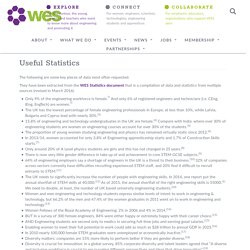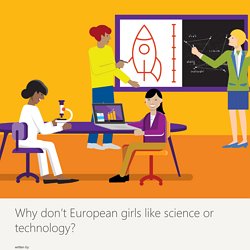

Why aren’t there more women in science? The industry structure is sexist. Why are so few women publishing scientific papers?

It is a question that has been posed by New Scientist magazine, as it reports that in medicine, female authorship of scientific papers has started to go backwards. Since 2009, the proportion of women as lead authors has gone down. The Real Reason Most Women Don't Go Into Tech, According To Women. Pisa 2012 results gender eng. The Real Reason Most Women Don't Go Into Tech. Facts & Figures – Girls for Technology Dev. Women's Engineering Society. The following are some key pieces of data most often requested.

They have been extracted from the WES Statistics document that is a compilation of data and statistics from multiple sources (revised in March 2016). Only 9% of the engineering workforce is female.(1) And only 6% of registered engineers and technicians (i.e. Other Useful Reports The following are other WES pages and external reports that make good reading. If you know of other reports or statistics not referenced by the WES Statistics document or listed above, or you have any query, email info@wes.org.uk, setting subject to WES Statistics. National Girls Collaborative Project. State of Girls and Women in STEM This NGCP resource presents the most compelling statistics for girls and women in STEM.

Statistics include information on K-12 Education, Higher Education, and Workforce and will be updated on a regular basis. K-12 Education. Women in Science, Technology, Engineering, and Mathematics (STEM) Data and sources for Global, Australia, Canada, Europe, India, Japan, and the United States.

Global Women Are Scarce in Scientific Research and Development Averaged across regions, women accounted for less than a third (28.4%) of those employed in scientific research and development (R&D) across the world in 2013. Central Asia (47.1%), Latin American and the Caribbean (44.3%), Central and Eastern Europe (39.9%), and the Arab States (36.8%) are regions in which women represent over a third of the R&D workforce. Women Are Less Likely to Enter, More Likely to Leave Tech-Intensive Business Roles. Girls' Education in STEM. Facts and Figures: Cracking the Code: Girls’ and Women’s Education in Science, Technology, Engineering and Mathematics (STEM) Key indicators show we’re deprived of the talents and potential contributions of millions of women due to clear gender-based discrepancies in STEM education and occupations The gender gap in STEM education is striking.

In higher education, only 35% of all students enrolled in STEM-related fields are females. Enrolment is particularly low in ICT (3%); natural sciences, mathematics and statistics (5%); as well as engineering, manufacturing and construction (8%). Participation is highest in health and welfare (15%) studies.
In Europe, only 29 of 1,000 female graduates had a degree in computing in 2015, and just four out of 1,000 went on to have ICT careers. Microsoft girls in STEM final Whitepaper. Why don’t European girls like science or technology? - Microsoft News Centre Europe. “They say science is quite hard.

But I say if you put your mind to it, it’s quite easy.” Twelve-year-old Paisley Edwards is from the UK, and one of millions of girls across Europe taught science, technology, engineering and maths (STEM) in school. Like most young women her age, she loves these subjects, which is great for her future career – companies are embracing technology to bring their working practices into the 21st century, and they need digitally-skilled staff to help them with that. Edwards is lucky, she has a role model: her mum is a scientist at a pharmaceutical company. In comparison, Microsoft’s study found that 61% of Italian girls felt they had access to encouraging role models but just 34% of Dutch girls said the same. If Edwards gets stumped on classwork, she takes it home and asks her mother for help. In estate si imparano le STEM. Prorogato al 28 febbraio 2017 il bando per le scuole relativo ai campi estivi di scienze, matematica, informatica e coding. Graduatoria stem del 19062017. Noi Siamo Pari - Il portale delle Pari Opportunità.
Il mese delle STEM. Le studentesse vogliono contare! Il mese delle STEM.

Le studentesse vogliono contare! Il Dipartimento per le pari opportunità ha da tempo avviato, anche in collaborazione con il Ministero dell’Istruzione, Università e Ricerca, iniziative volte a promuovere le pari opportunità e a contrastare gli stereotipi di genere nei percorsi scolastici. Opening Schools to STEM Careers - EUN Academy. It is widely known that Europe needs more young people to pursue STEM (Science, Technology, Engineering and Mathematics) subjects and careers to become part of a much-needed qualified workforce in the upcoming years.

At the same time, a wide range of factors affects students’ interest and pursue of STEM careers. From the given curriculum to teachers’ knowledge to even participation in professional development activities. Whatever these, they will be usually directly linked to school organization. For this reason, it will be of much importance to build capacity to empower the most relevant stakeholders in school leadership and school organization. #womeninstem Education edition: l’8 marzo un webinar con donne straordinarie che ogni giorno a scuola lavorano con l’innovazione – Orizzonte Scuola. Gender equality in science: it takes a village. The scarcity of women in the ranks of working scientists has been in the news for a discouragingly long time.

Gender inequality in science varies among disciplines. By Lilian Nassi-Calò An uneven distribution in gender can be observed amongst academics in the fields of hard science, technology, engineering and mathematics, with men clearly predominating (Science, Technology, Engineering and Mathematics, STEM).

In some fields of the humanities, but by no means in its entirety, there is a predominance of women who have doctorates. Gender and Science. UNESCO’s Natural Sciences Sector works towards providing strong role models for women and girls in science throughout the world, building capacities of women in STEM, as well as supporting and promoting the contributions of women to scientific knowledge generation and dissemination to advance sustainable development.
For instance, since its creation in 1998, the UNESCO-L’Oréal For Women in Science (FWIS) partnership continues to be an outstanding vehicle to celebrate role models from all over the world and to support and inspire women and girls to engage in and pursue scientific careers, while networks such as the Organization for Women in Science for the Developing World (OWSD) serve to strengthen dialogue and lessons learned among women in science. Finally, the Sector aims to mainstream gender in all its activities, working groups, committees and programmes. Gender Equality in Science Will Require a Culture Shift. Last October news broke of allegations that University of California, Berkeley, astronomer Geoff Marcy had for years harassed female students. (Marcy, who denied some of the allegations, resigned.) The news reminded me of an experience I had in school.
I admired an instructor and was honored when he took me out for a celebratory dinner near the end of the course. After walking me home, he put his arms around me, and alarm bells began to ring. When I rebuffed the advance, he complied, but later my grade changed from “outstanding” to “pass.” I went on to complete my training in internal medicine and infectious diseases and embarked on a career as an HIV physician. The statistics bore out my hunch. The problem is not only outright sexual harassment—it is a culture of exclusion and unconscious bias that leaves many women feeling demoralized, marginalized and unsure. Stemettes raise awareness of International Women’s Day with weekend hackathon.
Stemettes held a two-day hackathon to raise awareness of International Women’s Day and encourage girls into science, technology, engineering and maths (Stem) careers. Co-founder of Stemettes Anne-Marie Imafidon said International Women’s Day was used by the network as a platform to raise awareness about women in Stem. It also aimed to encourage awareness and change in the industry, with engagement levels on the day showing that girls are looking for Stem opportunities “Encouraging girls to explore Stem from an early age is critical to influencing the education and career choices these young women will make in the future. What Lies Behind Gender Inequality in Education? Comunicato Stampa dell'11 febbraio 2016. In agenda: via al mese delle STEM, Mobility Conference Exhibition, Smau Padova.
Le Studentesse vogliono contare! Untitled. Il mese delle STEM: iniziative dal MIUR per la Giornata Internazionale della Donna. Un mese di riflessioni e approfondimenti nelle scuole per combattere gli stereotipi di genere e le discriminazioni: “Le Studentesse vogliono contare! NoiSiamoPari.it - Home page. Gender equality objectives for the Structural Funds period 2014+ The following objectives are to be pursued when drafting national or regional Operational Programmes, except when socioeconomic analysis shows no need to tackle a certain problem. The overarching objective “economic independence of men and women” (Gender Equality Strategy) has been on the agenda of the European Union for a long time and reflects the egalitarian gender equality model. All other objectives support the overarching objective or are preconditions for reaching it:
Objective of gender equality policy - Government.se. Inequality watch. Despite numerous improvements in women’s educational and employment outcomes, many OECD countries have not achieved gender equality in economic opportunities and outcomes. Despite numerous improvements in women’s educational and employment outcomes, many OECD countries have not achieved gender equality in economic opportunities and outcomes. On the occasion of International Women’s day on 8th March 2012, the OECD launches an on-line Gender Data Browser via www.oecd.org/gender/equality.
Rapport en. Gender Inequality Index (GII) Gender inequality remains a major barrier to human development. Girls and women have made major strides since 1990, but they have not yet gained gender equity. The disadvantages facing women and girls are a major source of inequality. All too often, women and girls are discriminated against in health, education, political representation, labour market, etc — with negative repercussions for development of their capabilities and their freedom of choice.
The GII is an inequality index. Un portale raccoglie i progetti delle scuole per avvicinare le ragazze alle STEM. Dall’8 marzo all’8 aprile ci sarà “il mese delle STEM”: una iniziativa che il ministero dell’Istruzione ha avviato con il Dipartimento delle Pari opportunità della Presidenza del Consiglio, per la promozione di innovazione e scienza nelle scuole tra le ragazze e i ragazzi, oltre gli stereotipi di genere.
STEM è un acronimo che si usa per indicare le materie scientifiche (Scienza, Tecnologia, Ingegneria e Matematica) a cui tradizionalmente si avvicinano di più i ragazzi, soprattutto per ragioni sociali e culturali. 10Y"+4Y'+3Y. X. Project Based Learning. Crime Scene Investigation Activities. CSI - Crime Scene Investigation - Forensic Science for Kids. Kids Ahead - Crime Scene Investigation Activities. Kids Love 2Learn.ca Resources. Michael Sandel: What's the right thing to do? Educational Leadership:Effective Grading Practices:Thought Experiments in the Classroom.
Robert J. Marzano Teachers can use this four-phase approach to guide students through a challenging but fruitful process. Thought experiments are a natural part of human cognition. We engage in a thought experiment when we watch the Super Bowl and try to imagine what the winning players will do during the locker room celebration or when we try to imagine how we'll go about telling our spouse that we spent more money than the budget allows on a new computer. A thought experiment occurs anytime we create a mental projection of some event that we can't actually observe at that point in time.
Thought experiments have a rich history in the development of knowledge.1 For example, Einstein used a thought experiment when he imagined himself running to catch up with a beam of light. Why Thought Experiments? What is STEM? Teachercomp_en.pdf. EU Skills Panorama - European Commission - Useful Resources. Elgpn. 21st Century Skills Definition.